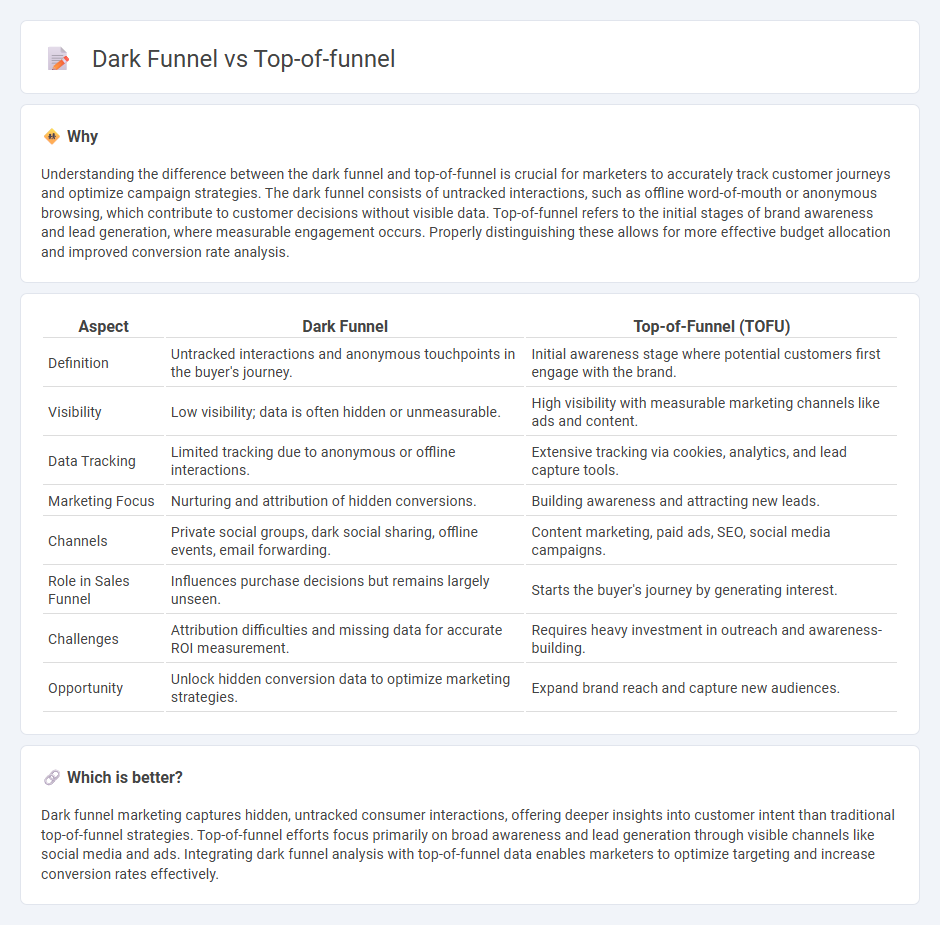
Dark funnel marketing captures anonymous or untraceable buyer interactions that traditional analytics miss, making it crucial for understanding hidden customer journeys. Top-of-funnel strategies focus on broad audience awareness through content marketing, social media, and advertising to attract potential leads. Explore our detailed comparison to optimize your marketing funnel and boost conversion rates.
Why it is important
Understanding the difference between the dark funnel and top-of-funnel is crucial for marketers to accurately track customer journeys and optimize campaign strategies. The dark funnel consists of untracked interactions, such as offline word-of-mouth or anonymous browsing, which contribute to customer decisions without visible data. Top-of-funnel refers to the initial stages of brand awareness and lead generation, where measurable engagement occurs. Properly distinguishing these allows for more effective budget allocation and improved conversion rate analysis.
Comparison Table
| Aspect | Dark Funnel | Top-of-Funnel (TOFU) |
|---|---|---|
| Definition | Untracked interactions and anonymous touchpoints in the buyer's journey. | Initial awareness stage where potential customers first engage with the brand. |
| Visibility | Low visibility; data is often hidden or unmeasurable. | High visibility with measurable marketing channels like ads and content. |
| Data Tracking | Limited tracking due to anonymous or offline interactions. | Extensive tracking via cookies, analytics, and lead capture tools. |
| Marketing Focus | Nurturing and attribution of hidden conversions. | Building awareness and attracting new leads. |
| Channels | Private social groups, dark social sharing, offline events, email forwarding. | Content marketing, paid ads, SEO, social media campaigns. |
| Role in Sales Funnel | Influences purchase decisions but remains largely unseen. | Starts the buyer's journey by generating interest. |
| Challenges | Attribution difficulties and missing data for accurate ROI measurement. | Requires heavy investment in outreach and awareness-building. |
| Opportunity | Unlock hidden conversion data to optimize marketing strategies. | Expand brand reach and capture new audiences. |
Which is better?
Dark funnel marketing captures hidden, untracked consumer interactions, offering deeper insights into customer intent than traditional top-of-funnel strategies. Top-of-funnel efforts focus primarily on broad awareness and lead generation through visible channels like social media and ads. Integrating dark funnel analysis with top-of-funnel data enables marketers to optimize targeting and increase conversion rates effectively.
Connection
The dark funnel represents the untracked consumer journey where potential customers engage with content and brands without giving identifiable data, often occurring through organic social interactions and private channels. Top-of-funnel marketing focuses on capturing attention and generating awareness through broad outreach tactics like content marketing and social ads, feeding leads into measurable channels. Connecting these concepts requires integrating dark funnel insights with top-of-funnel strategies to optimize lead attribution and enhance targeting accuracy across the entire customer acquisition cycle.
Key Terms
Awareness
Top-of-funnel marketing targets broad audiences to build brand awareness through measurable channels like social media ads and SEO, driving initial engagement with clear data tracking. Dark funnel activities involve anonymous or indirect interactions, such as private conversations and offline touchpoints, which are harder to track but significantly influence buyer decisions. Explore effective strategies to balance these funnels and maximize brand visibility.
Attribution
Top-of-funnel marketing targets a broad audience to generate initial awareness, while dark funnel involves untracked touchpoints hidden from traditional attribution models, such as organic research or peer recommendations. Attribution challenges arise as dark funnel interactions obscure the true customer journey, making it difficult to assign credit accurately across channels. Explore advanced attribution techniques to uncover hidden touchpoints and optimize your marketing strategy effectively.
Dark Social
Dark Social refers to the sharing of content through private channels such as messaging apps, emails, and direct messages, which are often untraceable by traditional analytics tools. Unlike top-of-funnel marketing that targets broad audiences through public channels like social media and search engines, Dark Social interactions are highly personalized and can drive significant, yet hidden, traffic and engagement. Explore how leveraging Dark Social insights can enhance your marketing strategy and uncover valuable customer behavior data.
Source and External Links
What is Top-of-Funnel Marketing? Tactics & Tips - Iterable - Top of funnel marketing is the first stage of the marketing funnel where customers are introduced to a brand and enter the awareness phase, focusing on creating broad awareness and nurturing interest without pushing for an immediate purchase.
What is Top of the Funnel - Definition by Insider - Top of the funnel refers to marketing activities aimed at creating brand or product awareness by educating and engaging a wide audience with content like blogs, social media, and SEO, focusing on buyer interests rather than direct sales.
Upper-Funnel vs. Lower-Funnel Marketing: What's the Difference? - Top-of-funnel marketing casts a wide net to attract early-stage potential customers by building brand awareness and establishing trust, which helps optimize the performance of the subsequent stages of the funnel.
 dowidth.com
dowidth.com